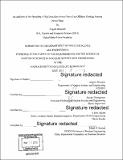| dc.contributor.advisor | Jacopo Buongiorno. | en_US |
| dc.contributor.author | Briccetti, Angelo (Angelo J.) | en_US |
| dc.contributor.other | Massachusetts Institute of Technology. Department of Nuclear Science and Engineering. | en_US |
| dc.date.accessioned | 2018-05-17T19:07:03Z | |
| dc.date.available | 2018-05-17T19:07:03Z | |
| dc.date.issued | 2015 | en_US |
| dc.identifier.uri | http://hdl.handle.net/1721.1/115452 | |
| dc.description | Thesis: S.M., Massachusetts Institute of Technology, Department of Nuclear Science and Engineering, 2015. | en_US |
| dc.description | "June 2015." Cataloged from student-submitted PDF version of thesis. | en_US |
| dc.description | Includes bibliographical references (pages 70-71). | en_US |
| dc.description.abstract | The offshore floating nuclear power plant (OFNP), is a new power plant design which provides for both increased safety and extra barriers to separate its radioactive material from the public. This design will minimize the probability of a severe accident leading to a release of radioactive material, but as always a release must still be planned for. The offshore siting of an OFNP allows for increased distance to human populations in addition to extra filtering of released radioactive material. This study will look at the potential consequences of a severe accident onboard an OFNP eventually leading to a vent and environment contamination. Three steps of the accident and fallout will be analyzed: 1) Accident and vent composition 2) The transport of radioactive material in the ocean via a plume and ocean diffusion 3) Sedimentation of radioactive cesium on the coast One of the major advantages of an OFNP over a terrestrial plant is that the extra distance and barriers provided by the OFNP will decrease the impact of a nuclear accident. This study will begin to quantify that effect. This is only the first attempt at exploring the effects of a release, and has large conservatisms built into the analysis even in the best estimate case. In the future more detailed work will be done to reach a more accurate solution, particularly for specific siting locations. | en_US |
| dc.description.statementofresponsibility | by Angelo Briccetti. | en_US |
| dc.format.extent | 71 pages | en_US |
| dc.language.iso | eng | en_US |
| dc.publisher | Massachusetts Institute of Technology | en_US |
| dc.rights | MIT theses are protected by copyright. They may be viewed, downloaded, or printed from this source but further reproduction or distribution in any format is prohibited without written permission. | en_US |
| dc.rights.uri | http://dspace.mit.edu/handle/1721.1/7582 | en_US |
| dc.subject | Nuclear Science and Engineering. | en_US |
| dc.title | An analysis of the spreading of radionuclides from a vent of an offshore floating nuclear power plant | en_US |
| dc.type | Thesis | en_US |
| dc.description.degree | S.M. | en_US |
| dc.contributor.department | Massachusetts Institute of Technology. Department of Nuclear Science and Engineering | |
| dc.identifier.oclc | 1035389712 | en_US |
